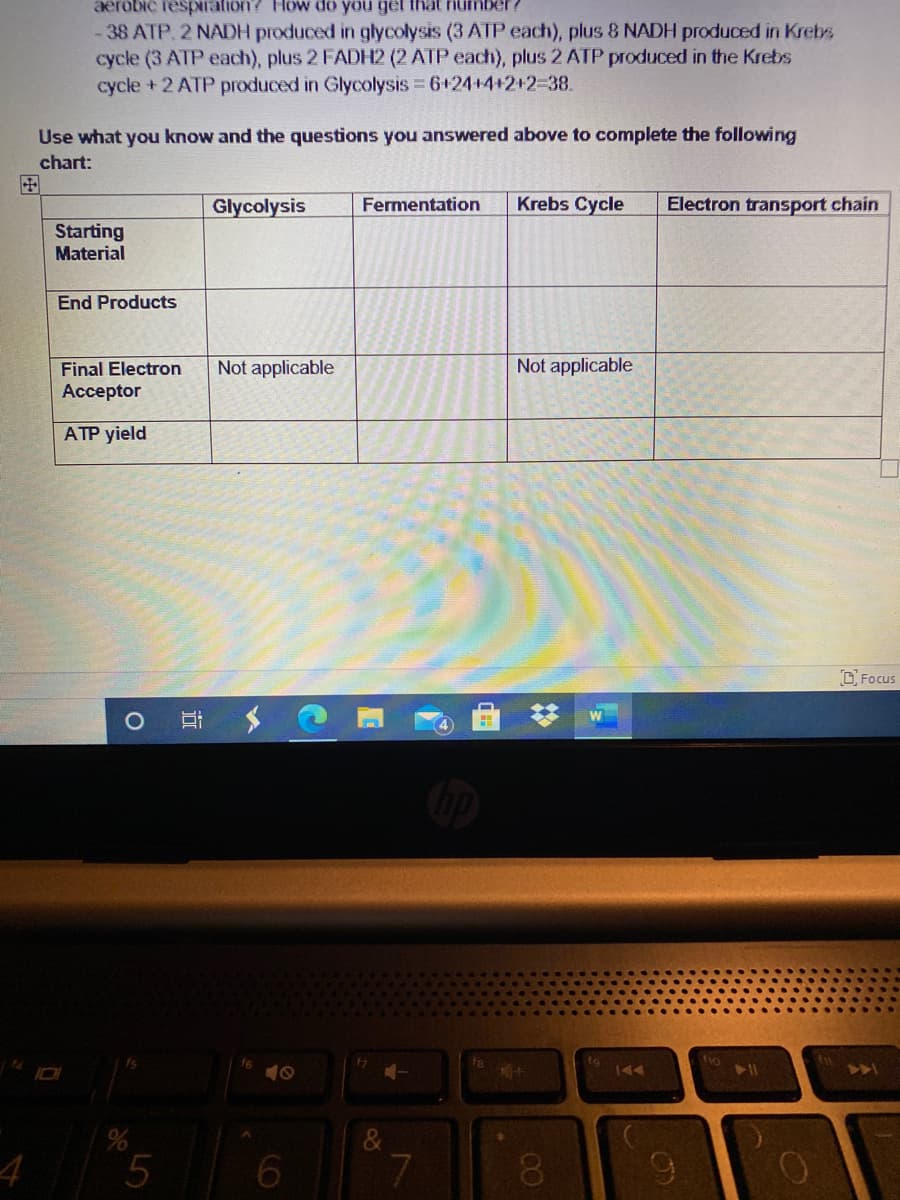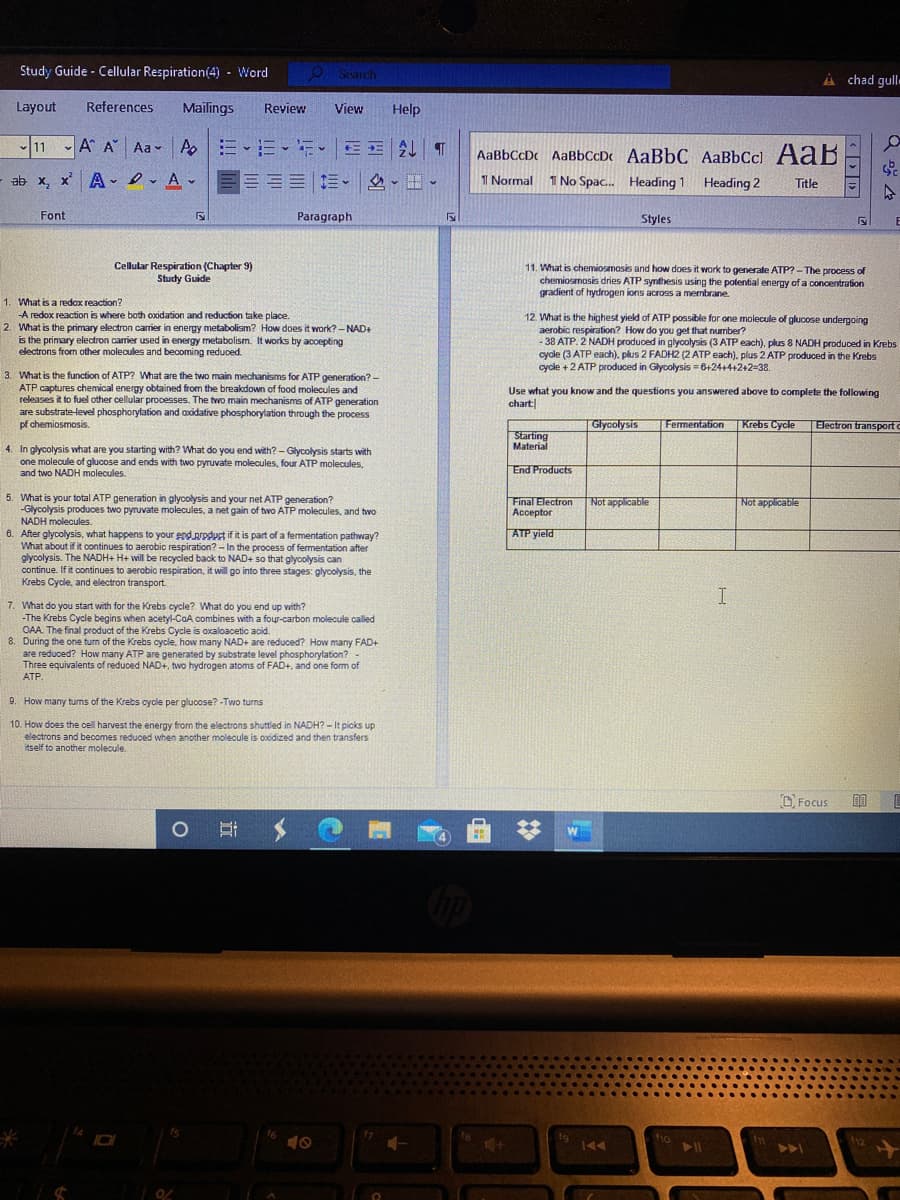Use what you know and the questions you answered above to complete the following chart: Glycolysis Fermentation Krebs Cycle Electron transport chain Starting Material End Products Final Electron Not applicable Not applicable Acceptor ATP yield
Use what you know and the questions you answered above to complete the following chart: Glycolysis Fermentation Krebs Cycle Electron transport chain Starting Material End Products Final Electron Not applicable Not applicable Acceptor ATP yield
Biochemistry
6th Edition
ISBN:9781305577206
Author:Reginald H. Garrett, Charles M. Grisham
Publisher:Reginald H. Garrett, Charles M. Grisham
Chapter20: Electron Transport And Oxidative Phosphorylation
Section: Chapter Questions
Problem 13P
Related questions
Question
Use what you know and the questions above to complete the following chart:

Transcribed Image Text:aerobic resprafion? How do you gel that number?
- 38 ATP. 2 NADH produced in glycolysis (3 ATP each), plus 8 NADH produced in Krebs
cycle (3 ATP each), plus 2 FADH2 (2 ATP each), plus 2 ATP produced in the Krebs
cycle + 2 ATP produced in Glycolysis 6+24+4+2+2-38.
Use what you know and the questions you answered above to complete the following
chart:
国
Glycolysis
Fermentation
Krebs Cycle
Electron transport chain
Starting
Material
End Products
Final Electron
Not applicable
Not applicable
Ассeptor
АТР yield
D Focus
10
144
4
6.
00
8

Transcribed Image Text:Study Guide - Cellular Respiration(4) - Word
O Starch
A chad gull-
Layout
References
Mailings
Review
View
Help
11 A A Aa - A
三
AaBbCcDc AaBbCcDc AaBbC AaBbCcl AaB
ab x, x' A-lrAv
目==|。
I Normal 1 No Spac. Heading 1 Heading 2
Title
Font
Paragraph
Styles
Cellular Respiration (Chapter 9)
Study Guide
11. What is chemiosmosis and how does it work to generate ATP?-The process of
chemiosmosis dries ATP synthesis using the potential energy of a concentration
gradient of hydrogen ions across a membrane.
1. What is a redox reaction?
-A redox reaction is where both oxidation and reduction take place.
2. What is the primary electron carrier in energy metabolism? How does it work? - NAD+
is the primary electron carier used in energy metabolism. It works by acoepting
electrons from other molecules and becoming reduced.
12. What is the highest yield of ATP possible for one molecule of glucose undergoing
aerobic respiration? How do you get that number?
- 38 ATP. 2 NADH produced in glyoolysis (3 ATP each), plus 8 NADH produced in Krebs
cycle (3 ATP each), plus 2 FADH2 (2 ATP each). plus 2 ATP produced in the Krebs
cycle +2 ATP produced in Glycolysis = 6+24+4+2+2=38.
3. What is the function of ATP? What are the two main mechanisms for ATP generation? -
ATP captures chemical energy obtained from the breakdown of food molecules and
releases it to fuel other cellular processes. The two main mechanisms of ATP generation
are substrate-level phosphorylation and axidative phosphorylation through the process
pf chemiosmosis.
Use what you know and the questions you answered above to complete the following
chart
Glycolysis
Fermentation
Krebs Cycle
Electron transporte
Starting
Material
4. In glycolysis what are you starting with? What do you end with? - Glycolysis starts with
one molecule of glucose and ends with two pyruvate molecules, four ATP molecules,
and two NADH molecules.
End Products
5. What is your total ATP generation in glycolysis and your net ATP generation?
-Glycolysis produces two pyruvate molecules, a net gain of two ATP molecules, and two
NADH molecules.
Final Electron Not applicable
Acceptor
Not applicable
ATP yield
6. After glycolysis, what happens to your end prpduct if it is part of a fermentation pathway?
What about if it continues to aerobic respiration? - In the process of fermentation after
glycolysis. The NADH+ H+ will be recycled back to NAD+ so that glyoolysis can
continue. If it continues to aerobic respiration, it will go into three stages: glycolysis, the
Krebs Cycle, and electron transport.
I
7. What do you start with for the Krebs cycle? What do you end up with?
-The Krebs Cycle begins when acetyl-CoA combines with a four-carbon molecule called
OAA. The final product of the Krebs Cycle is oxaloacetic acid.
8. During the one turn of the Krebs cycle, how many NAD+ are reduced? How many FAD+
are reduced? How many ATP are generated by substrate level phosphorylation? -
Three equivalents of reduced NAD+, two hydrogen atoms of FAD+, and one form of
ATP.
9. How many tums of the Krebs cycle per glucose? -Two turns
10. How does the cell harvest the energy from the electrons shuttled in NADH? - It picks up
electrons and becomes reduced when another molecule is oxodized and then transfers
itself to another molecule.
O Focus
112
Expert Solution
This question has been solved!
Explore an expertly crafted, step-by-step solution for a thorough understanding of key concepts.
This is a popular solution!
Trending now
This is a popular solution!
Step by step
Solved in 2 steps

Knowledge Booster
Learn more about
Need a deep-dive on the concept behind this application? Look no further. Learn more about this topic, biology and related others by exploring similar questions and additional content below.Recommended textbooks for you

Biochemistry
Biochemistry
ISBN:
9781305577206
Author:
Reginald H. Garrett, Charles M. Grisham
Publisher:
Cengage Learning

Biology (MindTap Course List)
Biology
ISBN:
9781337392938
Author:
Eldra Solomon, Charles Martin, Diana W. Martin, Linda R. Berg
Publisher:
Cengage Learning

Biochemistry
Biochemistry
ISBN:
9781305577206
Author:
Reginald H. Garrett, Charles M. Grisham
Publisher:
Cengage Learning

Biology (MindTap Course List)
Biology
ISBN:
9781337392938
Author:
Eldra Solomon, Charles Martin, Diana W. Martin, Linda R. Berg
Publisher:
Cengage Learning